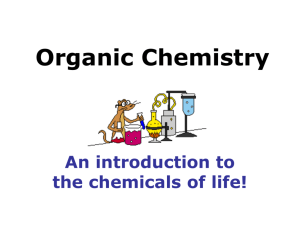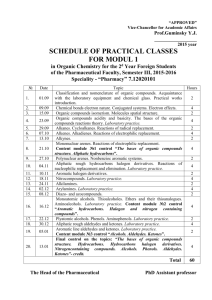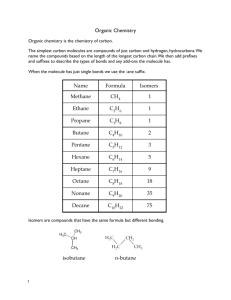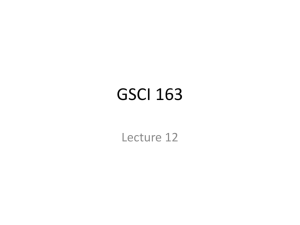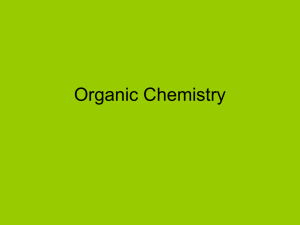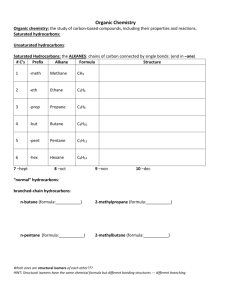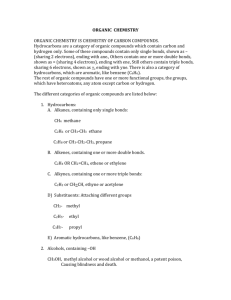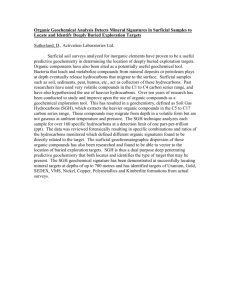Organic Nomenclature
advertisement
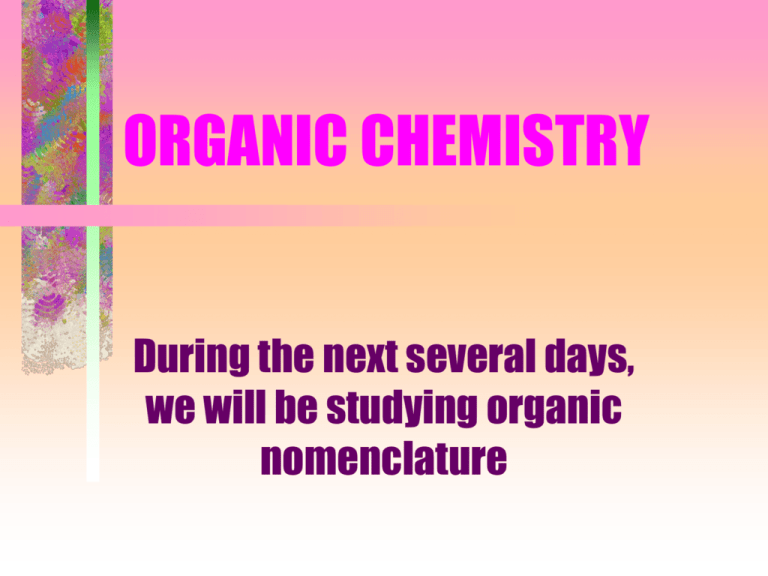
ORGANIC CHEMISTRY During the next several days, we will be studying organic nomenclature ORGANIC CHEMISTRY • This material will be a lot different – non-mathematical (you won’t need calculators) – a lot of memorization • It will be best to make a set of flashcards as we go along Daily work • During this unit, we will be having daily quizzes (no notes) • During this unit, you will be doing several worksheets • The quizzes start tomorrow Well, let’s get started • Organic chemistry is the study of carbon containing compounds • Remember, that carbon always makes four bonds • Organic compounds may also contain hydrogen, oxygen, nitrogen, sulfur, halogens, and other elements We will begin with hydrocarbons • Hydrocarbons contain only carbon and hydrogen • There are three types of hydrocarbons – Aliphatic – Alicyclic – Aromatic ALIPHATIC HYDROCARBONS • Aliphatic hydrocarbons contain chains of carbon atoms • There can be as few as one carbon and as many as several thousand in these chains • The chains can be “straight” or they can be branched ALICYCLIC HYDROCARBONS • Alicyclic hydrocarbons contain rings of carbon atoms • There can be as few as three carbons in a ring or as many as 10-15 • The ring systems are three dimensional, not flat AROMATIC HYDROCARBONS • Aromatic hydrocarbons usually contain six member carbon rings with alternating single and double bonds around the ring • The system of single and double bonds makes them aromatic rather than alicyclic • We will cover aromatic systems in detail later ORGANIC COMPOUNDS • Organic compounds can be thought of as being made up of a small number of different parts which can be assembled in an infinite number of ways. • The longest chain is considered the parent structure and the groups attached are called functional groups • There are many more organic compounds than inorganic compounds How are you doing so far? • Organic chemistry is very important for anyone pursuing any type of medical career • In college, organic chemistry is usually a two or three semester experience SATURATED VERSUS UNSATURATED • A saturated organic compound contains only carbon-carbon single bonds • They can be aliphatic or alicyclic, but not aromatic • An unsaturated organic compounds contains at least one carbon-carbon double or triple bond • They can be aliphatic, alicyclic, or aromatic Back to the aliphatic hydrocarbons • There are three types of aliphatic hydrocarbons – alkanes (single bonds only) – alkenes (at least one double bond) – alkynes (at least one triple bond) ALKANES • Also called the paraffins • They are saturated hydrocarbons (contain maximum number of hydrogen atoms) • Have the general formula, CnH2n+2 • Let’s consider the first twenty alkanes – look at page one of the handout – you should know names and formulas Here are the first 10 alkanes: • Methane = CH4 • Hexane = C6H14 • Ethane = C2H6 • Heptane = C7H16 • Propane = C3H8 • Octane = C8H18 • Butane = C4H10 • Nonane = C9H20 • Pentane = C5H12 • Decane = C10H22 MOLECULAR ISOMERS • Molecular isomers have the same formula, but different structure – the difference occurs based on how the carbon atoms are arranged – there can be many different isomers for the same formula ALKYL GROUPS • Alkyl groups are functional groups made from the alkanes – they are saturated – to name them, change the -ane ending to -yl – example: methane becomes methyl Naming organic compounds • In order to name organic compounds, a very systematic approach is used • The system is called IUPAC – Internation Union of Pure and Applied Chemistry Rules for IUPAC naming • Determine the parent structure (longest continuous carbon chain) and write down the name • Circle each substituent group (functional group) attached to the parent structure • Number the parent structure starting from the end closest to a substituent group More IUPAC rules • Write down the name of each substituent group preceded by a number showing the point of attachment to the parent structure • Use commas to separate numbers and hyphens to separate substituent groups • Use binary prefixes to indicate how many of each substituent group is present HOW ARE YOU DOING WITH ORGANIC? ALKENES • Also called the olefins • They are unsaturated hydrocarbons containing one or more carbon-carbon double bonds • They are named by changing the -ane ending to -ene • The simplest alkene is ethene (also called ethylene ALKYNES • Also called the acetylenes • They are unsaturated hydrocarbons containing one or more carbon-carbon triple bond • They are named by changing the -ane ending to -yne • The simplest alkyne is ethyne also called acetylene
